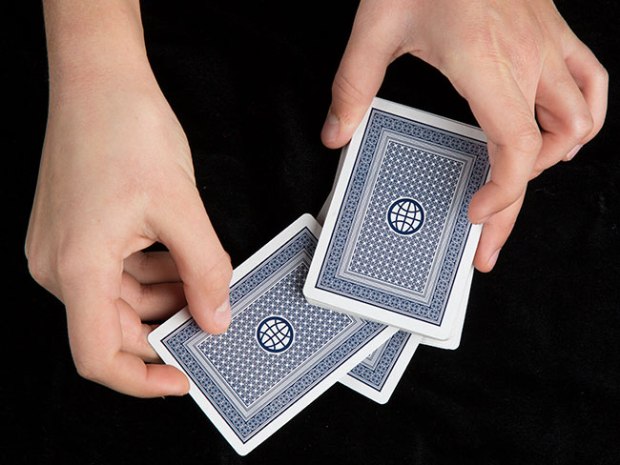The 1 to 10 Magic Card Trick
Players: 1
Ages: 5 and up
Cost: Free!
Math Ideas: problem solving, logical reasoning
Questions to Ask:
What strategies could you use to find the pattern?
What if I add another card, what will change?
Can you come up with your own pattern?
Y'all wanna see a magic trick?
Alright, I have in my hands ten cards. Nothing up my sleeves. Just watch and enjoy:
Ok, in case you're reading at work, I'll try to describe it. I cycle through the cards, counting 1, then 1,2, then 1,2,3, and so on. As I reach a number for the first time, I flip over my card. So the first time I say the number two, I flip over a card that just so happens to be a two. When I say three, I flip over a three. And I do that all the way up to ten cards.
Tada! It's the 1 to 10 Magic Card Trick!
How to Play
The way to play is simple: Just figure out the pattern yourself, then demonstrate the game to your kids. Then you just have to ask the magic question: "Can you figure out how to do this magic trick?"
Then they're off to the races! You might want to modify the number of cards in your trick depending on the ages of your kids. My kindergartner had quite a challenge with the 1 to 5 variation, and my middle schoolers loved 1 to 10. But I promise, each variation creates great chances for math talk.
Where's the Math?
In order to see the math of this game for yourself, you really need to try to figure it out!
Problem-solving is an amorphous concept in math, but essentially it refers to the set of strategies and approaches that people use to solve non-routine problems.
Anyone can memorize a formula, but what do you do when a problem requires more than a simple procedure? Guessing and checking, solving a simpler problem, and drawing a visual model are all problem-solving strategies that kids need experience using throughout their lives.
My son essentially used guess-and-check to solve the 1 to 5 card trick. He'd try an arrangement, see that it didn't work, and move some cards around until he found an arrangement that completed the trick. Not very formal, but eventually he got there.
When I show this trick to my middle schoolers, some of them opt to put the cards in numerical order, even though they know this isn't the solution. Then they run through the trick, waiting for something incorrect to happen. They flipped over a ten when they should have flipped over a four? Great, just switch the 10 and the 4 cards and try again!
Other students don't want to spend the time it takes running through the whole trick, card by card. They usually opt for paper and pencil. Draw ten blanks on the paper and start counting through. Put an ace in the first slot, then leave a blank and put a 2 in the next slot, and so on.
These strategies build on each other, becoming more strategic and efficient. Sometimes, a kid will use one strategy to solve the 1 to 10 trick, only to discover a better strategy when I push them to solve the 1 to 9 trick, or the 1 to 11 trick.
If you want your child to have a hands-on experience with problem-solving, give this a shot!
Questions to Ask
Your goal as a parent should be to act as a last resort for your child. If you give away the answer, or even the strategy, then you've robbed your kids of all the fun of the game!
At first, you can simply be a sounding board. Ask your child "What strategies could you use to find the solution?" and see what they say. They might not say much, especially if they're young. That's because the language of strategy is new to them. In that case, you could describe their own strategy to them in your words. Something like "Oh, so you're putting the cards in a random order and testing to see if that order works," would help your child see the structure in their work.
If your child does get frustrated, you can of course give them a hint about the strategy you used to solve the problem. But I'd shy away from giving away the answer. You never know what tantalizing problem, left unsolved one day, might provide hours of further exploration the next day or week or month.
Once they've solved the problem (and no, I'm not going to tell you the solution!), you can ask them "If I add another card, what will change?" Then they can test their hypothesis with the actual cards, which usually leads to some fascinating results.
Finally, you can ask your child "Could you come up with your own pattern?" The pattern used in the 1 to 10 trick is only one of many that I got from Dan Finkel, the creator of Tiny Polka Dot. Below is another. Maybe your child can come up with their own and stump you!




